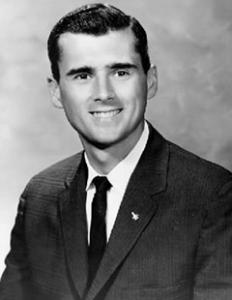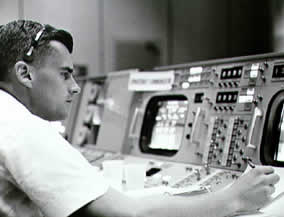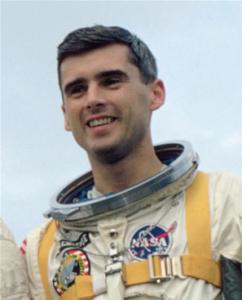Astronaut Roger Chaffee
Astronaut Roger Chaffee
By Fred Kelly, MD
When I arrived in Houston as the newest NASA flight surgeon in March of 1964, the third group of astronauts were getting settled in a new subdivision that had opened up across NASA Road 1 from the brand new Manned Spaceflight Center.
Although I knew the original seven from my work in Mercury and would work closely with the second group in Gemini, I became a neighbor and close friend with astronauts in the third group including Roger Chaffee.
 Astronaut Roger B. Chaffee
Astronaut Roger B. Chaffee
Photo: Courtesy NASA
From the first time I met Roger I was impressed at the way he seemed to stand out in a group that, by definition, represented the best that America had to offer. This first impression was enhanced as I got to know him better professionally and socially in our work environment and astronaut parties.
As a flight surgeon I had access to the confidential medical records and psychological evaluations of all the astronauts. These records only confirmed that my first impression of Roger Chaffee was correct.
Our paths had nearly crossed during the Cuban missile crisis when I was flying A4D Skyhawks at Naval Air Station Cecil Field. Roger was a few miles away at NAS Jacksonville flying A3D Skywarriors and taking pictures of Soviet missiles heading towards Cuba.

Astronaut Roger Chaffee at the console during the Gemini-Titan 3 flight.
Photo: Courtesy NASA
Maybe it was the fact that we were both Naval Aviators that brought us closer together or it might have been that both of us had played French horn in our high school bands, but I felt a special bond with Roger. He and Martha seemed to light up the room at astronaut parties. My wife, Jimi, and Martha became good friends.
When Roger was chosen as Pilot for the first Apollo mission, I was happy for his good fortune, even though he would be spending much of his time in Los Angeles. I was working on Skylab, and would spend much of my time in Huntsville.
The fact that he was chosen for this important mission proves that others had the same high opinion of Roger that I had. Gus Grissom was especially high in his praise, and praise from Gus was hard to come by. Other astronauts joked that Roger had adopted some of Gus's characteristics, and had even started to use some of Gus's colorful language that had been foreign to a straight arrow like Roger.
Besides being an excellent naval aviator, Roger was a graduate aeronautical engineer from Purdue. Gus was impressed at the way Roger related to engineers at North American. He recommended many changes to the Block I Apollo spacecraft. Unfortunately, not enough changes were made to render the spacecraft safe to fly.
But that is my opinion with the benefit of hindsight, and after participating in an extensive accident investigation. I might have made the same decision that Roger did given the pressure to get the Apollo Program going as early as possible.
 Astronaut Roger B. Chaffee
Astronaut Roger B. Chaffee
Photo: Courtesy NASA
Soon after the accident, Jimi was at Martha's house offering support. They were lying across Martha's bed talking quietly. Martha was hoping that Roger's face had not been burned too badly. Later, when I returned from the Cape, I was able to tell her that Roger's face was untouched by the fire.
I entered the spacecraft shortly after the hatch had been opened and could see that Gus had tried to help Ed White open the hatch. Roger was still strapped in. He died quickly from carbon monoxide poisoning while awaiting his turn to exit the spacecraft.
Dr. Fred Kelly, MD, is a specialist in aerospace medicine, a retired naval aviator and NASA flight surgeon.
He headed the medical panel of the accident board investigating the Apollo 1 pad fire that took the lives of three American astronauts including Roger Chaffee.






